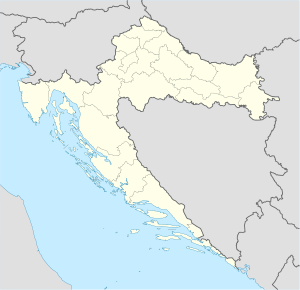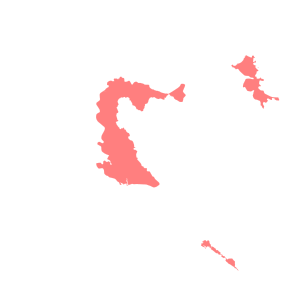Battle of Šibenik (1991)
| Battle of Šibenik | |||||||
|---|---|---|---|---|---|---|---|
| Part of the Croatian War of Independence | |||||||
|
Šibenik on the map of Croatia. JNA-held area in late December 1991 are highlighted red. |
|||||||
|
|||||||
| Belligerents | |||||||
|
|
|
||||||
| Commanders and leaders | |||||||
|
|
|
||||||
| Units involved | |||||||
| 221st Mechanised Brigade 46th Partisan Division 9th Mixed Artillery Regiment 11th Marine Infantry Brigade SAO Krajina TO |
4/4th Guards Brigade 113th Infantry Brigade Police |
||||||
| Casualties and losses | |||||||
| Unknown | 3 soldiers killed 49 soldiers wounded |
||||||
| 7 civilians killed 64 civilians wounded |
|||||||
The Battle of Šibenik (Croatian: Bitka za Šibenik), also known as the September War (Rujanski rat), was an armed conflict fought between the Yugoslav People's Army (Jugoslovenska Narodna Armija – JNA), supported by the Croatian Serb-established Serbian Autonomous Oblast of Krajina (SAO Krajina), and the Croatian National Guard (Zbor Narodne Garde – ZNG), supported by the Croatian Police. The battle was fought to the north and west of the city of Šibenik, Croatia on 16–22 September 1991, during the Croatian War of Independence. The JNA's initial orders were to relieve Croatian siege of their barracks in the city and isolate the region of Dalmatia from the rest of Croatia. The JNA's advance was supported by the Yugoslav Air Force and the Yugoslav Navy.
Fighting stopped following a Croatian counter-attack that pushed the JNA back from the outskirts of Šibenik. Although some ground was lost to the Yugoslavs, especially around the town of Drniš, northeast of Šibenik, the ZNG captured several JNA and Yugoslav Navy facilities in the city, including dozens of navy vessels and several coastal artillery batteries. The captured batteries were used to support defence of the city. The JNA Šibenik garrison was evacuated following an agreement between the Croatian officials and the JNA, except for several comparably small JNA posts in the city which were captured by the ZNG.
The September–October fighting caused three Croatian military and seven civilian deaths, as well as more than a hundred wounded. JNA bombarded Šibenik, causing damage to numerous structures, including the Cathedral of St. James, a UNESCO World Heritage Site. The New York Times judged the bombardment to be a part of calculated assaults on the heritage of Croatia. Artillery bombardment of the city continued over the following 100 days. The battle is commemorated in Šibenik each year.
...
Wikipedia


